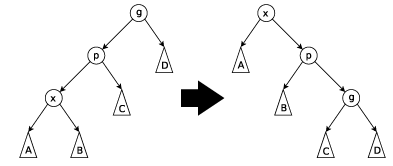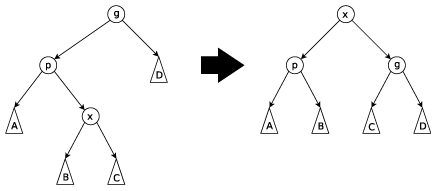Based on“Data Structures and Algorithm Analysis Edition 3.2 (C++ Version)” from C. A. Shaffer
Proporities
- A splay tree is a self-adjusting binary search tree with the additional property that recently accessed elements are quick to access again. To implement this, all normal operations on a binary search tree are combined with one basic operation, called splaying.
- Having frequently used nodes near the root is an advantage for nearly all practical applications, and is particularly useful for implementing caches and garbage collection algorithms.
- The most significant disadvantage of splay trees is that the height of a splay tree can be linear. Besides, the representation of splay trees can change even when they are accessed in a ‘read-only’ manner (i.e. by find operations). This complicates the use of such splay trees in a multi-threaded environment.
Operations
Splay
There are three types of splay steps, each of which has a left- and right-handed case. For the sake of brevity, only one of these two is shown for each type. These three types are:
1. Zig Step: This step is done when p is the root. The tree is rotated on the edge between x and p. Zig steps exist to deal with the parity issue and will be done only as the last step in a splay operation and only when x has odd depth at the beginning of the operation.

2. Zig-zig Step: This step is done when p is not the root and x and p are either both right children or are both left children. The picture below shows the case where x and p are both left children. The tree is rotated on the edge joining p with its parent g, then rotated on the edge joining x with p. Note that zig-zig steps are the only thing that differentiate splay trees from the rotate to root method introduced by Allen and Munro prior to the introduction of splay trees.

3. Zig-zag Step: This step is done when p is not the root and x is a right child and p is a left child or vice versa. The tree is rotated on the edge between p and x, and then rotated on the resulting edge between x and g.
Insert
To insert a node x into a splay tree:
- First insert the node as with a normal BST;
- Then splay the newly inserted node x to the top of the tree.
Remove
The first step of removing a node is just the same as removing a node in a BST; After deletion, we splay the parent of the removed node to the top of the tree, OR The node to be deleted is first splayed.
